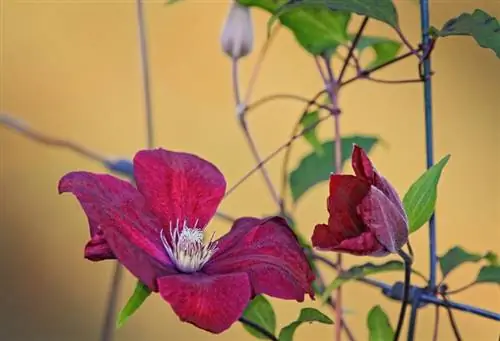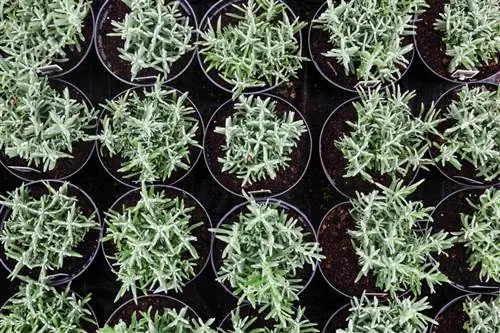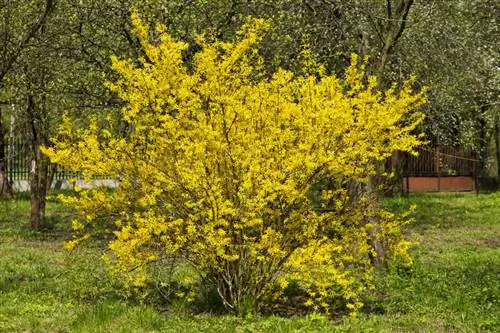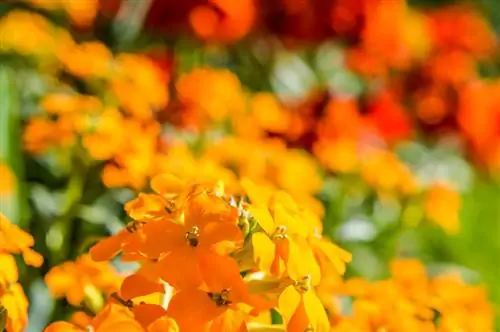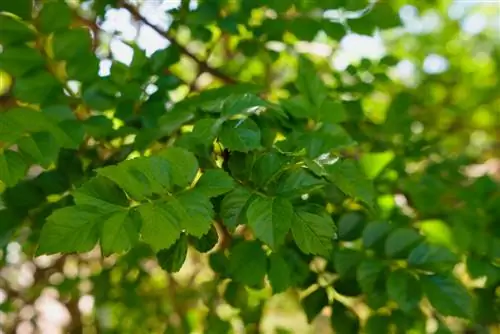- Author admin [email protected].
- Public 2023-12-16 16:46.
- Last modified 2025-01-23 11:20.
Cultivating a clematis is less delicate than generally assumed. By planting the opulent climbing plant correctly, you pave the way for vital growth over many years. The following planting instructions answer all important questions precisely and understandably.
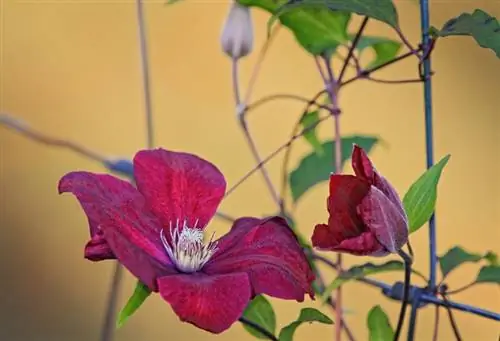
How do I plant clematis correctly?
Clematis thrive optimally in locations with sunny climbing areas that are not exposed to the midday heat and a shady root area. They should be planted in well-drained, humus-rich, nutrient-rich soil with a pH of 6.0 - ideally between August and October.
Where do clematis thrive?
The clematis likes to stretch its flower head towards the sun, while it prefers a shaded base. Clematis is ideal for planting facades, fences or pergolas facing west. Ideally there is shade from tall trees or a roof overhang, because the climbing artist does not want to be confronted with the blazing midday heat at the optimal location.
Is cultivation by sowing recommended?
You will not find the recommendation for sowing clematis in practical planting instructions. In fact, the seeds take up to 3 years to germinate. A vital clematis from the nursery, on the other hand, will bloom in the second or third year if you plant the young plant correctly.
When is the best time to plant?
The ideal planting time for clematis is from August to October. In the sun-warmed soil with temperatures between 14 and 22 degrees Celsius, there are perfect conditions for strong root growth. If you plant the clematis correctly according to these planting instructions, the flowering beauty will start the next season with a vital growth lead. With a little luck, you can look forward to a flower in the first year.
Alternatively, an appointment from mid-May can be considered. The Ice Saints should have said goodbye and the sun should have warmed the ground.
What should the substrate be like?
In order for the clematis to develop its dense foliage and lush flowers, this soil quality is important:
- Nutritious, humus-rich soil
- Freshly moist and well-drained
- Ideally a pH value around 6.0
If you prefer to plant the clematis in a pot, we recommend a high-quality pot plant soil. The substrate should be structurally stable, enriched with compost and sand as well as a handful of expanded clay or polystyrene beads for better permeability.
What aspects should you consider when planting?
Follow these planting instructions and prepare the soil for planting a clematis in late summer. Thoroughly loosen the soil and remove all weeds. In the meantime, place the still potted clematis in a bucket of water to thoroughly soak the root ball. The steps continue:
- Create a planting pit with 1.5 times the volume of the root ball
- Create a drainage 5-8 centimeters high at the bottom of the pit using gravel, grit or pottery shards
- Mix the excavated material with compost, horn shavings and leaf mold
- Unpot the soaked clematis and place it in the middle of the planting hole
- The correct way to plant clematis is with a slight slant towards the climbing aid
A clematis should be planted 7-10 centimeters deeper than in the container. The bottom two pairs of buds should be covered with substrate. Finally, water generously and continue in this way in the following days and weeks, because the clematis will not grow if there is drought stress.
Planting clematis correctly in a pot
If you assign a clematis to act as a privacy screen on the balcony, the smaller species and varieties will thrive wonderfully in the pot or balcony box. It is important to note that there is a sufficiently large volume of 30 to 40 liters and an integrated climbing aid. Otherwise, the planting instructions for the garden also apply here, although drainage above the water drain is of utmost importance.
What planting distance is considered appropriate?
The large Clematis family contains a wide variety of species and varieties. You will encounter robust, small-growing Clematis alpina and mighty Clematis montana with a height of up to 10 meters. A generally valid planting distance cannot therefore be defined. As a rule, the value is between 80 and 150 centimeters.
How to propagate clematis?
A he althy clematis provides plenty of plant material in summer for propagation using offshoots and cuttings. This form of breeding is much quicker than sowing. Here's how to do it:
- Cut cuttings 12-15 centimeters long from the middle part of a clematis
- Defoliate every cutting except for one leaf
- Dip the lower part with one eye in rooting powder (€9.00 on Amazon)
- Small growing pots filled with lean, moistened substrate to plant one cutting at a time
- Put a plastic bag over it so that it does not touch the offshoot
In a semi-shady place at 15 to 21 degrees Celsius, the cuttings root within 6 to 8 weeks. Until then, the hood is ventilated daily and the substrate is kept constantly moist.
Tips & Tricks
The undisputed dream team among flowering climbing plants is made up of clematis and climbing roses. In addition, the clematis cuts a fine figure in conjunction with witch hazel, waterfowl and laburnum. However, close proximity to rhododendrons should be avoided due to the very acidic soil.

